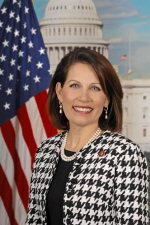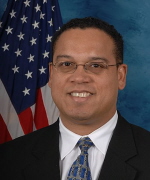How Competitive Are Minnesota’s Congressional Districts?
Bachmann’s 6th CD is the 11th most competitive in the nation since 2002; seven of the Gopher State’s eight CDs are more competitive than the national average
This report is the fourth in a series on the level of competitiveness across the nation’s 435 U.S. House districts. Previous installments analyzed which states have yielded the most competitive U.S. House races , the Top 50 most competitive U.S. House districts, and the 50 safest U.S. House districts since 2002.

Democrats also believe they can win Bachmann’s district.
Here’s why:
A Smart Politics analysis of 1,740 general election U.S. House contests since 2002 finds that Bachmann’s 6th Congressional District has been the 11th most competitive district in the entire country over the last four election cycles.
The average margin of victory in the 6th CD since 2002 has been 10.3 points – nearly 30 points lower than the nationwide average of 39.2 points.
Bachmann’s district is also the third most competitive district among the 100 U.S. House seats that comprise the 12-state Midwest region, behind only Indiana’s 9th CD (#3, 7.4 points) and Iowa’s 3rd CD (#8, 9.6 points).
Moreover, only three other seats held by Republicans nationwide represent districts that have had smaller average margins of victory across the last four election cycles than the 6th: Pennsylvania’s 6th CD (#1, 2.6 points, Jim Gerlach), Washington’s 8th CD (#7, 9.0 points, David Reichert), and Florida’s 13th CD (#8, 9.6 points, Vern Buchanan).

Kline won by 11.1 points over former Congressman Bill Luther in 2002, 16.1 points over Teresa Daly in 2004, 16.2 points over Coleen Rowley in 2006, and 14.7 points over Steve Sarvi in 2008. Despite these (relatively) modest victory margins, Kline’s seat is considered safe for the Republicans by all prominent D.C. prognosticators.
In total, three Minnesota congressional districts cracked the Top 100 most competitive in the nation (the 1st CD being the other, at #81), and seven of the Gopher State’s eight congressional districts were more competitive than the nationwide average of 39.2 points:
· MN-06: #11. Average margin of victory: 10.3 points.
· MN-02: #36. Average margin of victory: 14.5 points.
· MN-01: #81. Average margin of victory: 21.5 points.
· MN-03: #139. Average margin of victory: 27.7 points.
· MN-04: #182. Average margin of victory: 32.3 points.
· MN-08: #199. Average margin of victory: 33.8 points.
· MN-07: #233. Average margin of victory: 37.1 points.
· MN-05: #261. Average margin of victory: 42.4 points.
Only the state’s most liberal district, the 5th, was less competitive than the national average, at 42.4 points.

Of course, some districts are more competitive in 2010 than their four election cycle average would suggest – such as Erik Paulsen’s 3rd CD, which is skewed high due to the large victory margins posted when liberal Republican Jim Ramstad represented the moderate district. In the future, Minnesota’s 7th and 8th CDs will also become much more competitive when long-serving Congressmen Collin Peterson and Jim Oberstar decide to retire from office.
In total, Minnesota has had the 15th most competitive congressional elections across the 50 states, with an average victory margin of 27.5 points in its 32 races since 2002.
The Gopher State had the 17th lowest average margin of victory in U.S. House races statewide in 2002 (30.2 points), the 11th lowest in 2004 (26.6 points), the 17th lowest in 2006 (25.4 points), and the 16th lowest in 2008 (27.6 points).
Minnesota has had the 5th most competitive U.S. House races in the Midwest behind Iowa (#3, 15.9 average margin of victory), North Dakota (#4, 19.9 points), South Dakota (#6, 22.6 points), and Indiana (#8, 24.1 points).
However, only two other states with more competitive elections have an equal (Arizona, #12) or higher (Indiana, #8) number of congressional districts than Minnesota. As outlined in a previous Smart Politics report, states with the fewest number of congressional districts generally had the lowest average margins of victory in their U.S. House contests, while heavily-populated states with large numbers of districts generally yielded the least competitive races on average.
Another notch under Minnesota’s belt is that it is one of just 17 states across the country that has fielded both Democratic and Republican candidates in every U.S. House general election contest since 2002 – 32 out of 32 contests. And, with 8 congressional districts, only Washington (9 districts) and Indiana (9 districts) held more U.S. House contests among these 17 states across this four-election span.
Competitiveness of Minnesota’s Congressional Districts (margin of victory)
|
Rank
|
District
|
Current Rep.
|
’02
|
’04
|
’06
|
’08
|
Ave
|
|
11
|
MN-06
|
M. Bachmann
|
22.2
|
8.1
|
8.0
|
3.0
|
10.3
|
|
36
|
MN-02
|
J. Kline
|
11.1
|
16.1
|
16.2
|
14.7
|
14.5
|
|
81
|
MN-01
|
T. Walz
|
26.8
|
24.1
|
5.6
|
29.6
|
21.5
|
|
139
|
MN-03
|
E. Paulsen
|
44.1
|
29.3
|
29.9
|
7.6
|
27.7
|
|
182
|
MN-04
|
B. McCollum
|
28.3
|
24.3
|
39.3
|
37.1
|
32.3
|
|
199
|
MN-08
|
J. Oberstar
|
37.4
|
33.0
|
29.2
|
35.6
|
33.8
|
|
233
|
MN-07
|
C. Peterson
|
30.7
|
32.3
|
40.7
|
44.5
|
37.1
|
|
261
|
MN-05
|
K. Ellison
|
41.1
|
45.3
|
34.3
|
48.9
|
42.4
|
Data compiled from Office of the Clerk, U.S. House of Representatives by Smart Politics.
Follow Smart Politics on Twitter.

very interesting analysis. thanks for posting this was very helpful to me for a paper I was writing.